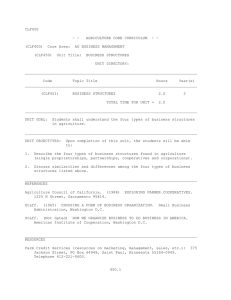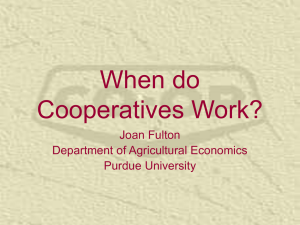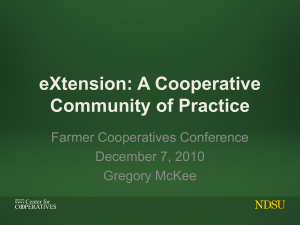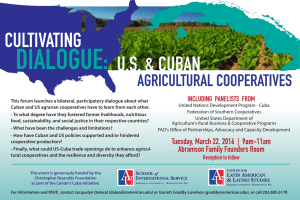Economics of Cooperative Cooperating Phil Kenkel Bill Fitzwater Cooperative Chair
advertisement
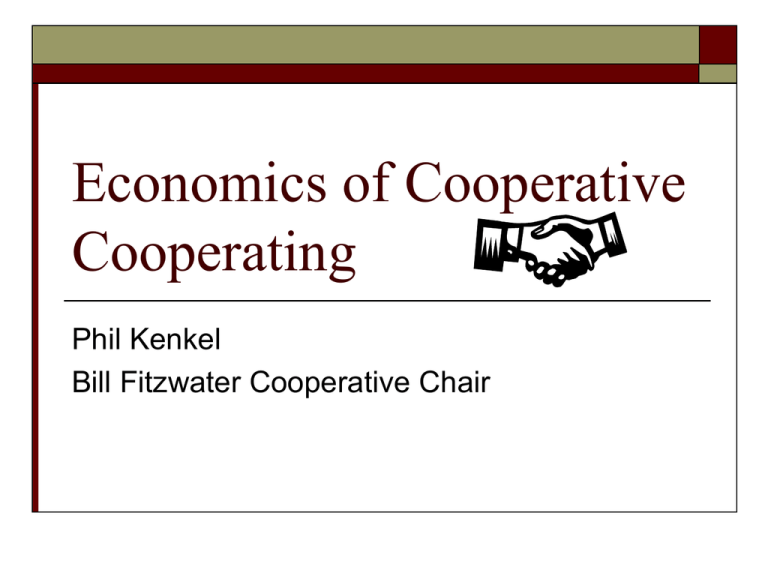
Economics of Cooperative Cooperating Phil Kenkel Bill Fitzwater Cooperative Chair Cooperatives Among Cooperatives is Nothing New International Cooperative Alliance Cooperative Principles Voluntary and open membership Democratic member control Member economic participation Autonomy and independence Education, training and information Cooperation among cooperatives Concern for community Capper-Volstead Act of 1922 Persons engaged in the production of agricultural products as farmers, planters, ranchmen, dairymen, nut or fruit growers may act together in associations, corporate or otherwise, with or without capital stock, in collectively processing, preparing for market, handling, and marketing in interstate and foreign commerce, such products of persons so engaged. Such associations may have marketing agencies in common; and such associations and their members may make the necessary contracts and agreements to effect such purposes. Unique Legal Status of Cooperatives An agricultural cooperative is entirely exempt from the provisions of the antitrust laws, both as to its very existence as well as to all of its activities, provided it does not enter into conspiracies or combinations with persons who are not producers of agricultural commodities United States v. Maryland & Virginia Milk Producers Association, Inc., 167 F. Supp. 45, 52 (D.D.C. 1958), rev 'd. 362 U.S. 458 (1960 Historic Adjustments by Cooperatives Formed federated cooperatives to: Manufacture Merchandise Export Data and accounting services Consolidated and Merged: Reduce costs Eliminate redundant assets Combined identity, patronage and equity Recent Adjustment by Cooperatives Create alliances with companies where there are mutual interests Benefit from facilities without owning them Maintain centralized identities and patronage paths Abandoned absolute control for exit strategies if the mutual interest evaporates Cooperatives are Cooperating Why Was Your Cooperative Formed? Economies of scale Market power or to keep the market honest Supply missing product, service or infrastructure The same forces justify cooperation among cooperatives Cooperatives Cooperating Joint purchasing Joint marketing Sharing employees Sharing equipment Shared infrastructure Sharing inventory Sharing information Sharing education and promotion Economic Forces for Cooperation Economies of scale Specialization Asset utilization Gain market power Economies of Scale The increase in efficiency of production as the number of goods being produced increases. Example: 24 ton/day canola crushing operation has a crushing cost of $48/ton while a 300 ton/day facility has a cost of $28/ton OSU Fertilizer warehouse study showed $5-10/ton advantage to centralized warehousing Cooperatives Cooperating to Obtain Economies of Scale Grain alliance: reduced merchandizing, hedging and borrowing costs Farm supply cooperatives in Colorado jointly purchase fertilizer, fuel and fence posts Cooperatives in Kansas combined feed mill operations into a single more efficient feed mill Economies of Scale (continued) Cooperatives combining propane and/or fuel delivery services Oklahoma cooperative combining cotton ginning operations Midwest Stores Cooperative: Natural Foods Cooperatives in fifteen towns and six states combined there purchasing and warehousing functions Economies of Scale Central Valley Ag- East Central Nebraska as joint venture of Tri-Valley Coop, Central Farmers Coop and Ag Land 43,000 ton automated dry fertilizer warehouse with unit train unloading capability Load semis in 10 minutes with no operators Increased sales by 100% Specialization: Human Resources Shared purchasing manager Agronomist or animal health technician shared by two or more cooperatives Shared access to regulatory compliance experts-Triangle Companies in Oklahoma, shared employees in Colorado Market Power Grain alliances gain better access to flour mill markets Colorado grain cooperatives coordinated their rail shipments and negotiated better rail rates Asset Utilization Unit train load out facilities Terminal grain storage Propane and fuel delivery Fertilizer application equipment Asset Utilization Farm supply cooperatives created an informal strategic alliance to coordinate inventory with neighboring cooperatives Exchange products at cost Minimize inventory while satisfying member needs Enabled them to find the specific tire for a producer to get them back in the field Education/Promotion Touchstone Energy Joint member education and training seminars Management training program Centralized employee training Cooperation Among Cooperatives Opportunities Fertilizing application and warehousing Inventory management- can we link our point of sale inventory systems? Promotion: Do we need to promote the coop brand? Summer internships
